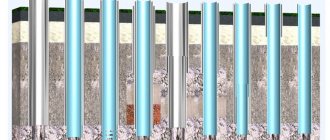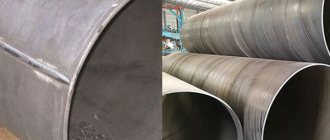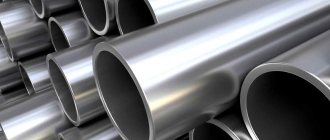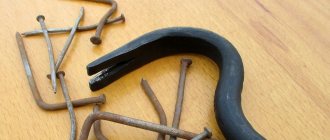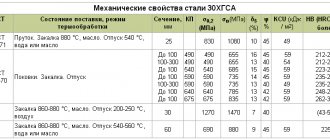When selecting the necessary equipment for a well, you need to pay the most attention to the drilling pipes (otherwise known as casing strings). Their main function is to ensure that water resources from the layer containing them enter the well after passing through the filter. Subsequently, the pump pumps the water upward. Also, with the help of columns, the wellbore is strengthened and isolated from the aquifers located above.
But before you start drilling, you need to decide on the type of pipe suitable for the well.
The purpose of pipes and their features
Typically, products with standard dimensions are used for drilling. The most commonly used sizes are: 32, 90, 114, 125 mm, etc.
A higher pipe diameter is chosen when the efficiency of the pump and the system supplying the facility with water is high. But you shouldn’t get too carried away and take it with too much reserve. With a high cross-section, the pressure decreases and the price rises.
Using pipes of different formats:
- 32mm - a pipe through which water can be supplied to a 10-meter height. In this case, an externally located self-priming pump (hydrophore) is used. There is a hose running to the water inside;
- 90-125 mm - such a pipe is used to place a submersible pump in it if the well depth exceeds 10 m.
How to choose the right pipe format
The diameter is selected based on a number of factors.
Among them:
- planned well depth;
- flow rate - the volume of water planned for supply;
- pump and submersible equipment options;
The following requirements are attached to the column for its effective operation;
- reliable fit of the column to the drilled hole;
- ensuring the supply of the required volume of water;
- resistance to deformation under pressure.
How to choose a pipe based on the expected well depth
In different places, the soil has a varied structure, which may have varying degrees of mobility. Therefore, to choose the right pipe, you need to know from which layer the pump will pump water. You can find out about the depth of the water layer, as well as the condition of the soil, from those who live in the neighborhood, or you can conduct an engineering-geological examination to order.
Wells are divided into three types based on depth:
- Abyssinian. Its depth is up to 10 m, and it is fed by surface waters. Pipes suitable for this well have a diameter of 32 mm.
- "On the sand." Its depth can vary from 10 to 80 m. Casing is done using a 90 or 125 mm pipe. With the help of such a well you can provide water to a country house. For example, 99% of wells belong to this type.
- Artesian version (otherwise called “limestone”). Designed for the water layer, located mainly at a depth of 80 meters or more. This is already the 3rd or more aquifer. A pipe with a cross-section of 120 mm or more will also be selected according to the type of pump.
An important point: to drill a well to the 1st aquifer, you do not need to specifically obtain any permits. All other types of wells are design ones.
Application
The casing pipe has a cylindrical shape and is installed in the drilled well. Its main function is to seal and protect the well from soil collapse.
It is mainly made of plastic, and the most popular material is PVC (polyvinyl chloride). This material has a lot of advantages - low weight, good technical and operational characteristics, high quality protection against freezing and deformation, ease of delivery and installation. For the oil and gas industry, casing pipes can be made of metal or composite materials.
High-quality pipes (both plastic, metal or composite) reliably prevent clogging with soil, and also have a long shelf life (50 years or more), do not deform under mechanical stress and are able to withstand large temperature changes.
The casing pipe is suitable for constructing oil and gas wells, as well as for creating wells with drinking or industrial water. They are often used in construction to create bored supports. High-quality, reliable pipes must have a good degree of sealing - this is especially critical in the case of gas or oil wells, as well as in the case of artesian wells with deep water underground.
Selection of pipe according to well flow rate
The flow rate is the most important property of the layer in which there are water reserves, characterizing the well’s ability to produce a specific volume of cubic meters of water per hour. During drilling operations, specialists determine the water recovery rate, which must be recorded in the well certificate upon completion of the work. This document is given to the owner.
Preliminary selection of the pump is carried out taking into account the nominal flow rate. The stereotype about the direct dependence of water output on the diameter of the pipe is not entirely true. In this case, the duty cycle of the filter (that is, the percentage of holes in its total area), as well as the quality of the aquifer itself, is of greater importance. Thus, water passes through sand with large grains several tens of times more efficiently than through silty soil.
5th option: telescopic design
- During the drilling process, rocks are encountered that significantly complicate the work (loose soils, boulders, silicified limestones and others).
- Limestone is aquiferous, pressure. The water level in the well is higher than the limestone level.
- The required source capacity is for water supply to a private home.
A telescopic water well design is used (Figure 5). This happens in cases where geological difficulties are encountered along the path of the drilling tool: boulders, loose soils, silicified limestone and others. Therefore, until this point, the well is lined with an initial steel casing pipe (133 mm or 159 mm). Next, there is a transition to drilling and casing with steel pipes of smaller diameter, which are installed on limestone. In limestone, the water well is not cased and an open shaft remains, which serves as a water inflow.
6th option: telescopic design
- During the drilling process, rocks are encountered that significantly complicate the work (loose soils, boulders, silicified limestones and others).
- Limestone is aquiferous, but not pressure-bearing - the water level in the source trunk is lower than the level of limestone.
- The required well productivity is for water supply to a country house.
A telescopic well design is used (Figure 6). As in the previous option, before geological complications, the water well is lined with an initial steel casing pipe of 133 mm or 159 mm. Next, there is a transition to drilling and casing with a steel column of smaller diameter, which is already placed on limestone. In limestone, an additional column is installed, consisting of casing pipes of even smaller diameter, into which the pump will be installed. The water inflow in this case is an open hole or casing perforations.
The article discusses the main structures of artesian wells often used when drilling. In fact, there are more designs. Each variation is applied individually in a specific case.
Pump size and type
To calculate the casing, it is necessary to draw up a diagram according to which the object will be supplied with water. All points that should be provided with water are applied to it. The maximum costs for plumbing are summed up, and the minimum performance of the device is judged by the sum of the indicators.
If you don’t make calculations, you can focus on average statistics. For example, the optimal water consumption for 4-5 people is 3 cubic meters per hour. A larger number of residents and the presence of a household increase the amount of resource consumed to 5 cubic meters. m.
It is worth paying attention: the pump must have the highest possible performance 25% less than the well flow rate. If at any point the water is completely pumped out, there is a risk that the more powerful pump may burn out.
A pump with certain dimensions can be selected by brand. To calculate the size of the casing pipe, you need to know the outer diameter of the pump, indicated in the passport, add 4-5 mm to it (this is the minimum gap that allows the pump to move freely), as well as the wall thickness, multiplied by two.
When calculating the diameter of the most popular pumps, the following results are usually obtained:
- if the flow rate is from 3 to 7 cubic meters. m per hour, then a pump with a diameter of 3 inches (76 mm) is suitable, which can be installed in a pipe having an outer diameter of 89;
- provide productivity from 5 to 14 cubic meters. m. per hour is capable of a 4-inch (102 mm) pump coupled to a casing pipe whose outer diameter is 104.
Four-inch pumps are the most popular, while three-inch pumps are not as numerous, but are no less reliable than the larger ones. Thin devices are slightly lighter in weight, but have a more impressive length (25-30%) than their larger counterparts. One of the most famous 76 mm options is “Aquarius”, which consumes 2 cubic meters. per hour, mounted in a pipe with a diameter of 100 mm, and its version is 4.3 cubic meters. per hour suitable for 125 mm pipe.
Selection rules
There are two types of criteria, consideration of which allows you to accurately decide which pipe is best to use for a water well, these are:
- Technical.
- Operational.
Factors of the first category include:
- Diameter.
- Method of connecting pipe sections.
- Type of material.
Choosing the diameter of the casing pipe Source ytimg.com
The diameter of the casing pipe for a well is calculated using a special formula, taking into account a number of parameters. It is generally accepted that along the internal contour its value should be at least 110 mm. This is due to two reasons - optimal water intake conditions and the selection of submersible pumping equipment of suitable dimensions.
The well will have better performance characteristics when the pipe segments are fastened with a threaded connection. It will ensure maximum tightness, strength and durability of the casing. In most cases, the installation company decides what diameter the installed pipe string should be and what type of connection is required for it in a particular case.
Factors of the operational category of criteria for choosing a pipe for casing:
- Inertness of the material relative to aggressive environments.
- Resistance to external compression of soil masses.
- Endurance relative to mechanical loads - to ensure integrity during transportation and installation.
- Increased resistance to corrosion.
- Long service life.
- Optimal cost.
Three modern materials meet the requirements: steel, plastic and asbestos cement.
Note! Which pipes are best to use for a water well must be decided in advance - before searching for an installer. Typically, a company works with only one material and has in its arsenal special equipment and proven technology for a specific type of pipe.
Casing pipe with thread Source vostokpipe.ru
See also: Catalog of companies that specialize in water supply, sewerage and related work
How to decide on the material
There are a large variety of pipes on the market today, both steel and plastic. Let's consider their comparative characteristics.
Advantages and disadvantages of steel
For the production of steel pipes, ordinary steel is usually used, less often - stainless steel coated with zinc or enamel.
The advantages of such a pipe:
- mechanical strength - the pipe, which has walls 6 mm thick, is resistant to any ground displacements, so you can safely clean the well without fear of damaging anything;
- tightness - welding of individual pipes together is very reliable, so water from the upper layers cannot penetrate into the pipe;
- such a pipe must be repaired; if the pipe outlet is well sealed with the head, then it will be resistant to rust;
- durability - such a pipe will last about 50 years, and this has been confirmed by practice.
Stainless steel products have one big drawback - they are expensive. Chips may form on the enamel surface during installation, which can lead to rust in the near future. Galvanized pipes have a lower price, but interaction with water leads to the formation of zinc oxide, which, according to some assumptions, poses a health hazard.
The disadvantages of iron pipes include their instability to chemical reactions and corrosion, short service life, heavy weight and poor hygiene, unlike PVC.
Advantages and disadvantages of plastic
The advantages of PVC pipes include:
- chemical resistance;
- long service life (this is still tentative, since PVC pipes began to be used relatively recently);
- lightness and low cost when compared with iron ones (although in reality the price of a well with such a pipe will practically not differ from the cost of a well with an iron analogue).
The following disadvantages were found in PVC pipes:
- low mechanical stability (movement of soil layers can lead to breaking or collapse of the pipe). Therefore, these pipes are not used to equip wells deeper than 80 m;
- poor tightness at threaded joints, especially when there is “saving” on sealing agents, and in these places water from the upper layers can enter the well. When forming a casing, PVC pipes are screwed into each other, and sometimes soldered together with a coupling where they are inserted;
- These pipes are practically unsuitable for repair, since it is not possible to repair the plastic structure;
- they are negatively affected by low temperatures. If the well is installed incorrectly and the water is located close to the surface, freezing of water in winter can lead to rupture of the plastic;
- the insufficiently studied (and it is possible that negative) effects of PVC on human health when water from a well equipped with such pipes is used for drinking and cooking. At the same time, the manufacturer is assured that these pipes are absolutely safe and comply with GOST standards.
If you have any questions or doubts before purchasing casing pipes for a well, our managers will be happy to help you choose pipes and send the necessary samples free of charge by the transport company.
When purchasing casing pipe from TZPT LLC (Tula), you can always be sure of the quality guarantee, as well as the best price from the manufacturer!
Which well is better made of plastic or metal?
At the end, we will summarize, especially for those who are too lazy to read all the material, we will immediately resolve the question of which casing pipe is better than HDPE or steel. Plastic is good and allows you to reduce the cost of drilling, it works great, but if protected by an iron pipe. A steel pipe is also good, but it is installed before the limestone, and the limestone itself must be lined with plastic. In our area (in the south of the Moscow region) it is impossible to leave limestone without casing. Therefore, the ideal combination is iron and plastic. If you don’t trust HDPE, you can overpay and make metal and metal.
